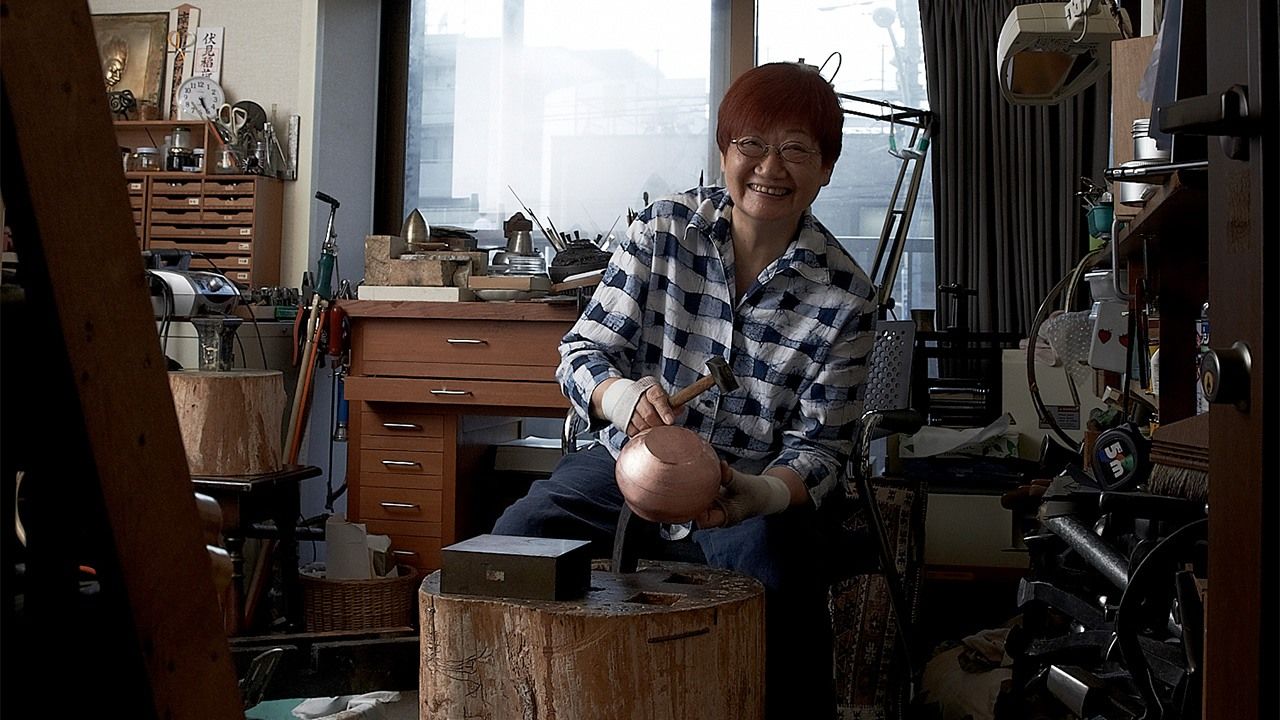
Ōsumi Yukie: The Brilliance of Metalworking
Culture History- English
- 日本語
- 简体字
- 繁體字
- Français
- Español
- العربية
- Русский
Transforming the Transient into a Permanent Presence
“Metal isn’t hard. It’s soft. When you work silver or other metals into the form of a vessel, they’re warmed by your hands, becoming one with you and transforming into your desired shape.”
I had always thought that metal was hard. But Ōsumi Yukie’s works are solemn, yet soft in appearance.
For example, there is this flower vessel, created from silver, copper and shakudō (a Japanese alloy of gold and copper). It is titled Red Sea and is a marvelous expression of the evening light on the sea.
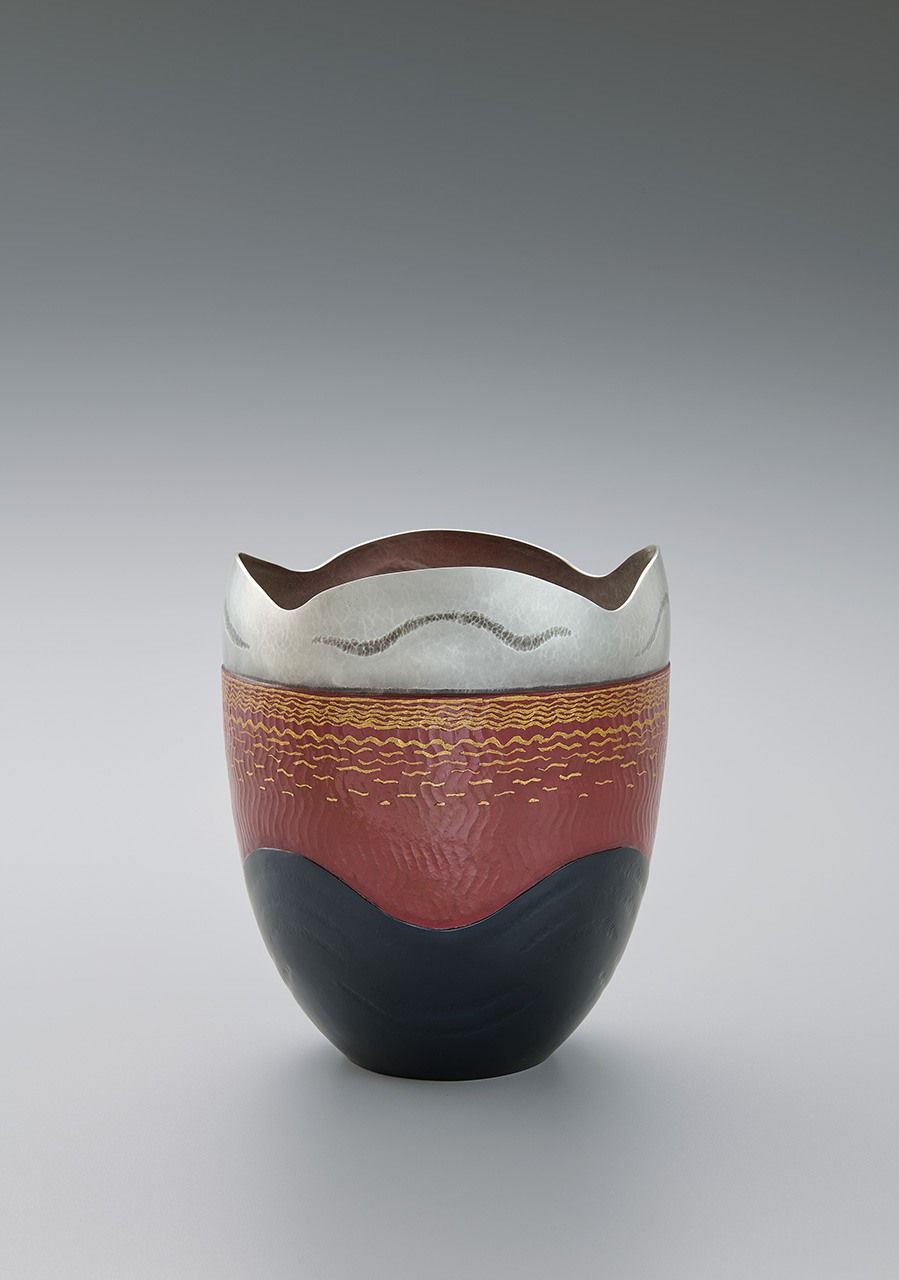
Red Sea, a silver, copper and shakudō flower vessel, joined using a heat welding method. Exhibited at the sixty-ninth Japan Traditional Kōgei Exhibition (2022). (Courtesy the Japan Kōgei Association)
“It may be because I spent my childhood in the Shizuoka countryside, but my attention is drawn to natural objects. I find it particularly interesting to take motifs of things that have no definite shape, like waves, wind, and clouds and then fix them in the form of a vessel. Metal is very durable and difficult to break, the opposite of nature’s fragility, making it a reliable material to transform this transience into a permanent presence.”
Ōsumi creates her works by combining two techniques: tankin (hammer forming), where the metal is struck with a hammer or wooden mallet to form a vessel, and chōkin (metal engraving) in which decorative elements are carved into the surface of the metal using a chisel. It is an extremely complex process.
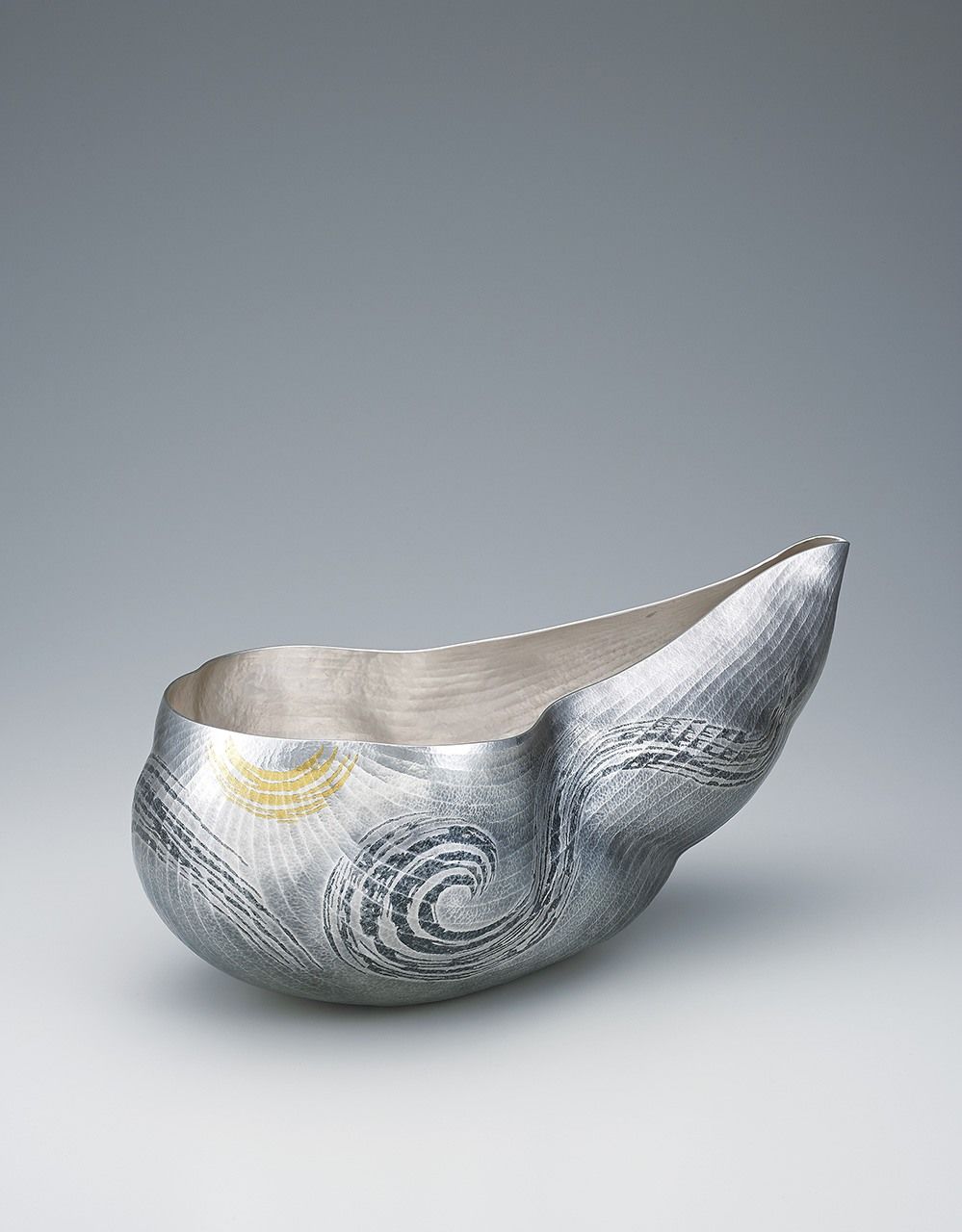
Auspicious Cloud, a silver flower vessel made using hammer forming. Exhibited at the sixty-fifth Japan Traditional Kōgei Exhibition (2018). (Courtesy the Japan Kōgei Association)
Materials That Resonate When Struck
In the case of her work Auspicious Cloud, a silver hammer-formed vessel, she first annealed a flat sheet of silver using a gas burner, then patiently hammered it with a hammer and wooden mallet on a dish-shaped wooden base as well as a sandbag and other types of bases. Once the vessel took form, she further beat it with a wooden mallet to create the form of a bulging cloud.
Next, she made a rough sketch on the surface and used a metal hammer to finely beat it, leaving those sketch lines intact so as to create wave-like three-dimensional ridges. She also used a chisel, striking it with a small hammer to make fine cuts known as mekiri horizontally, vertically, and diagonally across the surface. She then applied lead foil, working it into the grain with a willow chisel, after which she removed the excess and fully hammered in the lead to complete this decorative technique known as nunome zōgan.
“One piece takes from three to six months to complete. It is demanding work, but metal is a material that resonates when struck, responding sensitively to the force applied to it. Pottery is completed through firing, so that final process is entrusted to the fire, and the temperature will significantly impact the finished product. Metalwork, in contrast, has no processes left to nature so the results can almost always be predicted. Its form is considered beautiful if it is methodical and without flaw. It’s that distinctive character of the metal that matches my temperament and I think it’s one of the reasons I have continued doing metalworking for so long.”
Ōsumi’s aspirations for metalworking began while she was a university student. She chose to study at Tokyo University of the Arts because she was drawn toward the world of art and beauty. Her plan was to study art history, but when she actually started attending, she found herself surrounded by people creating paintings, sculptures, and various other works. Having loved working with her hands since she was little, Ōsumi soon began thinking she would like to make something too.
“As a child, I loved art classes the best and even at home I would make dolls out of chiyogami decorative paper and then donate them to kindergartens. When I think of that, it may be natural that I was drawn into the world of creation as a student.”
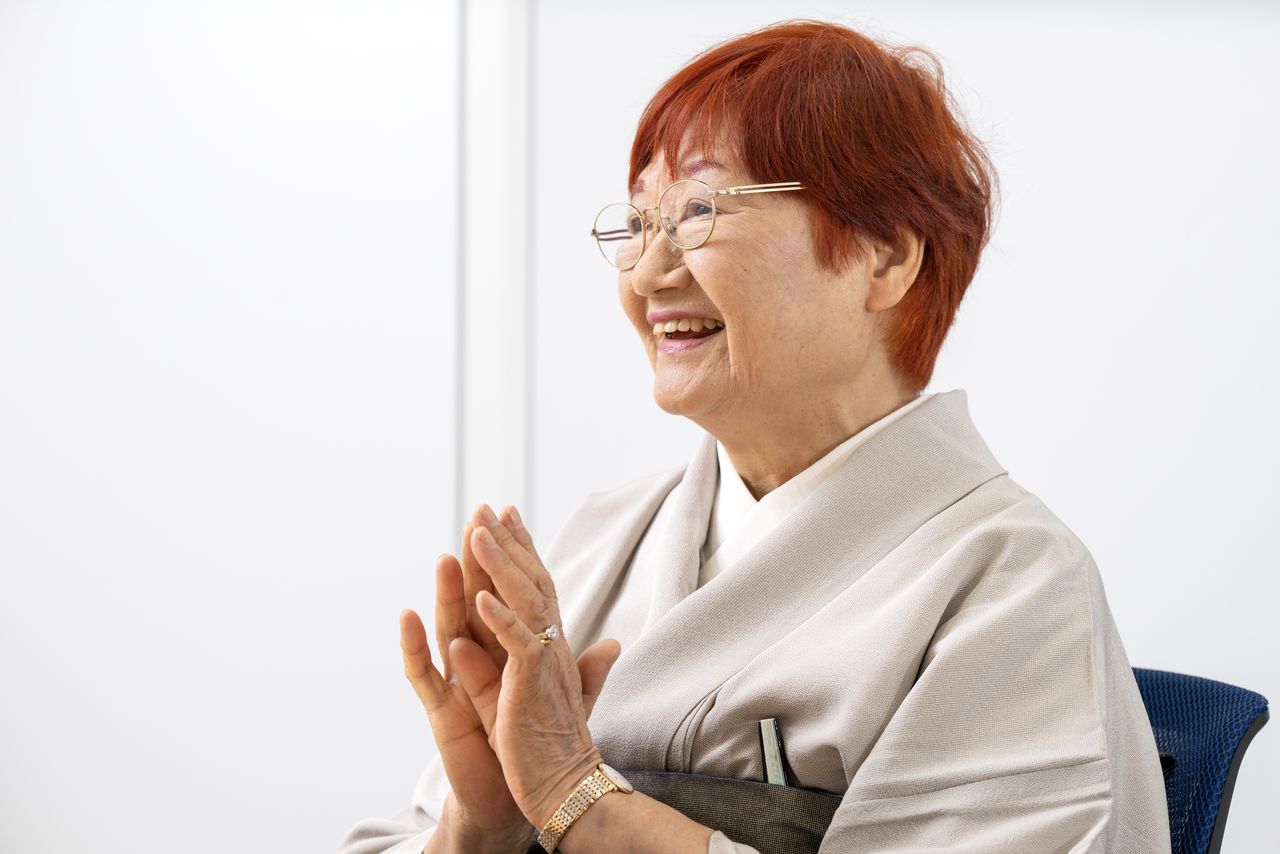
Ōsumi Yukie was “drawn into the world of creation.” (© Yokozeki Kazuhiro)
Combining the Techniques of Three Teachers
Ōsumi felt that craftwork, which combines beauty with practicality, rather than art, was a better choice. However, in order to figure out which was the best craftwork field for her, she first needed to study a certain number of practical skills and familiarize herself with the materials. She tried a number of different crafts, including pottery, dyeing, and lacquer work. At the time though, it was not possible for her to study such practical skills in other departments, so she took classes outside of the university.
“Metalwork takes physical effort, so at the time it was mainly a male-dominated field with little attraction for women. But I found clay was too soft, making it hard for me to grasp, while lacquer gave me a skin rash, so I didn’t have much choice . . . All that was left for me was metalwork. A more positive reason is that I was drawn to the material. The sleek feel of the metal and especially the deep, magnificent colors and brilliance of the gold and silver endlessly fascinate me.”
To build up her skills, she started by making accessories in a chōkin metal engraving class taught by a senior student at the university. After graduation, she relied on her connections to gain an introduction as an apprentice to Katsura Moriyuki, a leading artisan of metal accessories, such as obidome (sash clasps). As her knowledge of chōkin expanded, she began thinking that she wanted to make not only surface decorations, but also the bodies of the vessels that would form the base for those decorations.
She received an introduction from Katsura to study under Sekiya Shirō, designated a living national treasure for tankin in 1977. This allowed her to master the technique of making tsuchimeji vessels, in which patterns are hammered into the surface. After that, she became interested in the technique of nunome zōgan, in which a fine mesh-like decorative pattern is engraved into the surface of the metal, learning it from Kashima Ikkoku, designated a living national treasure for chōkin in 1979.
“I create my works by using the engraving techniques Katsura-sensei taught me as the foundation, the forging techniques I gained from Sekiya-sensei to make hammered vessels, and then finally by applying the nunome zōgan technique learned from Kashima-sensei. Basically, my style of work is a result of combining all those techniques. I feel I have been blessed with great teachers.”

Sunset, a silver flower vessel made using hammer forming. Exhibited at the sixty-eighth Japan Traditional Kōgei Exhibition (2021). (Courtesy the Japan Kōgei Association)
Skills Honed Through a Succession of Part-Time Jobs
Despite Ōsumi building up her skills though, there was little demand for metalwork products and moreover, it was still a male-dominated society. It therefore proved difficult to earn a living from the craft.
It was still normal those days for women to stay at home, but Ōsumi felt “I wanted to live doing ‘something,’ even if I didn’t know what it was,” and so, along with continuing to hone her skills, she worked in various jobs.
Straight after university, she was a part-time art instructor. A year later, she switched to being a Japan Patent Office examiner, looking at design applications. This only lasted around one year though as she felt the working environment did not suit her, and for a while after that she moved from one part-time job to another, all related to design. She then returned to the Tokyo University of the Arts to work as an assistant and after eight years she became an associate professor at Tokyo Kasei University. She was 41 when she was finally able to acquire a permanent position.
“My mother was over 90 and needed support, so up until five years before retirement I worked at Tokyo Kasei University. I created a new Art and Design department, becoming its head, and introduced a course in metalworking to establish it as a subject. Even while I was working, I kept creating pieces and continued showing them at exhibitions too. I was extremely busy and it was probably because I was young that I could do that.”
She carried on in this way, perfecting her craft, and in 2015, at 69, she found herself designated a living national treasure for tankin. This was the first time a woman had received such recognition in the field of metalworking. A 2015 Ministry of Cultural Affairs press release praised her work, saying that “the flowing ridgelines and the distinctive metallic colors complement the vast beauty of the vessel form, creating a unique style that brims with contemporary sensibilities.”
“The designation was so completely unexpected; it took me by surprise. It was just something that happened, so I didn’t feel any pressure due to the fact I’m a woman. Still now, I find areas I could improve on in my works. But in the past ten years or so, I’ve been able to sense when the metal is telling me things, like it doesn’t want to bend any more, and that has led to me to feeling more joy in my work. Now I’m most interested in ‘communicating’ with the materials, seeking forms that come about naturally without force.”
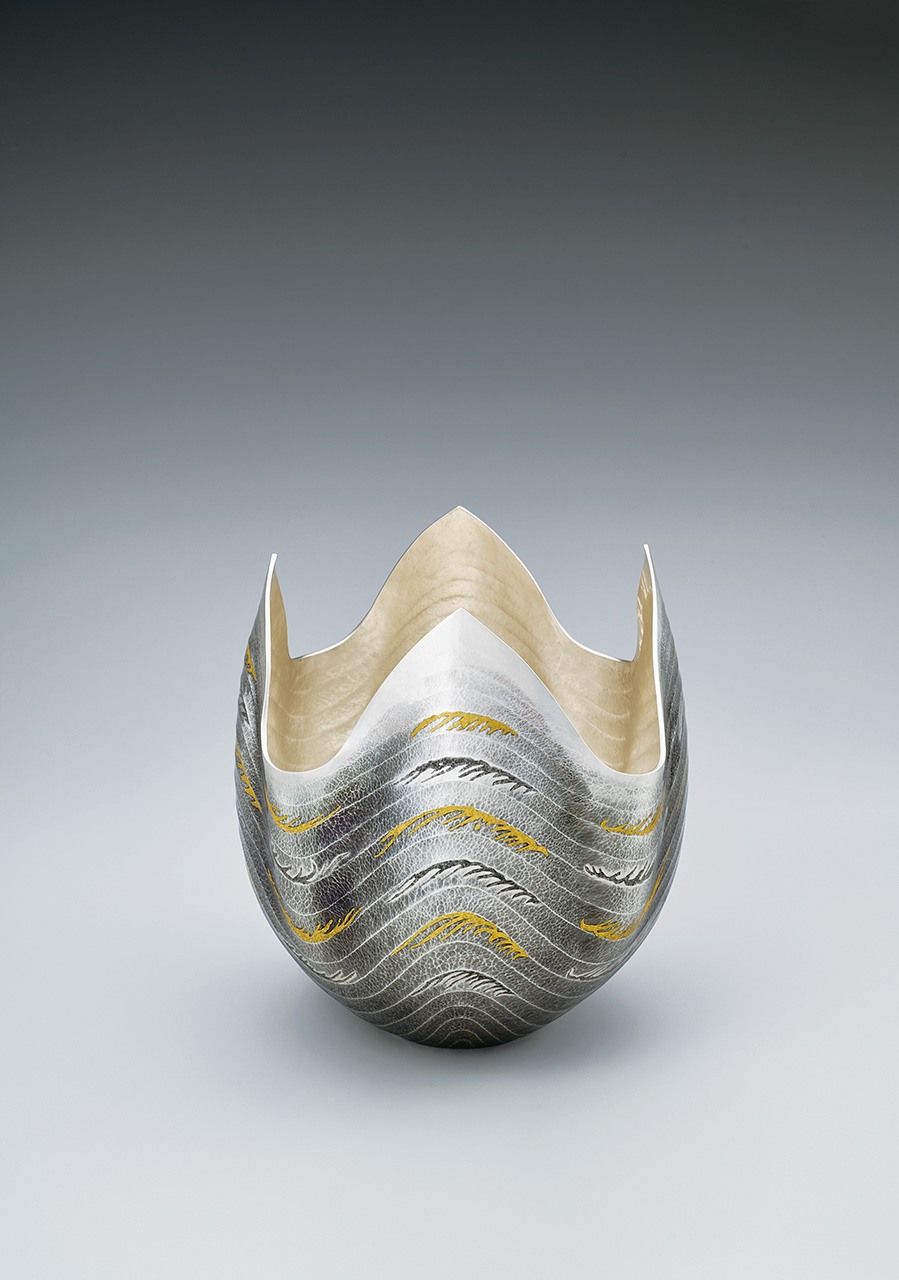
Spring Tide, a silver flower vessel made using hammer forming. Exhibited at the seventieth Japan Traditional Kōgei Exhibition (2023). (Courtesy the Japan Kōgei Association)
People are Natural Creators
It might seem like craftsmanship requires some special quality, but Ōsumi says that this is not the case.
“In the same way that birds build nests, humans too are natural creators. I think people especially are naturally gifted in consciously creating beautiful things. These days we can buy anything we want, and at first it might seem like we are living in abundance, but tea now usually comes in a plastic bottle, and I feel life without a teapot to make tea in is poor and that kind of lifestyle is empty.
“The act of creating things is an essential part of human nature, but the problem is that we’ve forgotten that. I’ve kept creating things just because I like doing it, but I’d feel so grateful if there was a ripple effect where people saw these artisanal works, actually used them, and then realized how natural creation is. This I believe is the power of traditional crafts.”
(Originally published in Japanese. Interview and text by Sugihara Yuka and Power News. Banner photo © Kawakami Teruaki; interview photos © Yokozeki Kazuhiro.)
